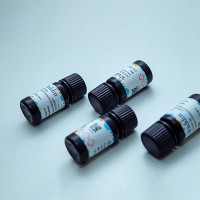Interaction Trap/Two‐Hybrid System to Identify Interacting Proteins
互联网
- Abstract
- Table of Contents
- Materials
- Figures
- Literature Cited
Abstract
The yeast two?hybrid method (or interaction trap) is a powerful technique for detecting protein interactions. The procedure is performed using transcriptional activation of a dual reporter system in yeast to identify interactions between a protein of interest (the bait protein) and the candidate proteins for interaction. The method can be used to screen a protein library for interactions with a bait protein or to test for association between proteins that are expected to interact based on prior evidence. Interaction mating facilitates the screening of a library with multiple bait proteins. Curr. Protoc. Neurosci. 55:4.4.1?4.4.35. © 2011 by John Wiley & Sons, Inc.
Keywords: protein interactions; yeast two?hybrid; interaction trap; interaction mating
Table of Contents
- Introduction
- Basic Protocol 1: Producing and Characterizing a Bait Strain
- Alternate Protocol 1: Confirmation of Fusion Protein Synthesis by Repression Assay
- Basic Protocol 2: Performing an Interactor Hunt
- Alternate Protocol 2: Performing a Hunt by Interaction Mating
- Support Protocol 1: Preparation of Sheared Salmon Sperm Carrier DNA
- Support Protocol 2: Yeast Colony Hybridization
- Support Protocol 3: Microplate Plasmid Rescue
- Reagents and Solutions
- Commentary
- Figures
- Tables
Materials
Basic Protocol 1: Producing and Characterizing a Bait Strain
Materials
Alternate Protocol 1: Confirmation of Fusion Protein Synthesis by Repression Assay
Basic Protocol 2: Performing an Interactor Hunt
Materials
Alternate Protocol 2: Performing a Hunt by Interaction Mating
Support Protocol 1: Preparation of Sheared Salmon Sperm Carrier DNA
Materials
Support Protocol 2: Yeast Colony Hybridization
Materials
Support Protocol 3: Microplate Plasmid Rescue
Materials
|
Figures
-
Figure 4.4.1 The interaction trap. (A ) An EGY48 yeast cell containing two LexA operator–responsive reporters, one a chromosomally integrated copy of the LEU2 gene (required for growth on−Leu medium), the second a plasmid bearing the lacZ reporter gene (causing yeast to turn blue on medium containing Xgal). The cell also contains a constitutively expressed chimeric protein, consisting of the DNA‐binding domain of LexA fused to the probe or bait protein, shown as being unable to activate either of the two reporters. (B ) and (C ) The resulting bait strain has been additionally transformed with an activation domain (act)–fused cDNA library in pJG4‐5, and the library has been induced. In (B), the encoded protein does not interact specifically with the bait protein and the two reporters are not activated. In (C), a positive interaction is shown in which the library‐encoded protein interacts with bait protein, resulting in activation of the two reporters (arrow), thus causing growth on medium lacking Leu and blue color on medium containing Xgal. Symbols: black rectangle, LexA operator sequence; open circle, LexA protein; open pentagon, bait protein; open rectangle, noninteracting library protein; shaded box, activator protein (acid blob in Fig. ); open chevron, interacting library protein. View Image -
Figure 4.4.2 Flow chart for performing an interaction trap. View Image -
Figure 4.4.3 LexA fusion plasmid pEG202. The strong constitutive ADH promoter is used to express bait proteins as fusions to the DNA‐binding protein LexA. Restriction sites shown in this map are based on pEG202 sequence data and include selected sites suitable for diagnostic restriction endonuclease digests. A number of restriction sites are available for insertion of coding sequences to produce protein fusions with LexA; the polylinker sequence and reading frame relative to LexA are shown below the map with unique sites marked in bold type. The sequence 5′‐CGT CAG CAG AGC TTC ACC ATT G‐3′ can be used to design a primer to confirm correct reading frame for LexA fusions. Plasmids contain the HIS3 selectable marker and the 2‐µm origin of replication to allow propagation in yeast, and the Apr antibiotic resistance gene and the pBR origin of replication to allow propagation in E. coli . In the plasmids pMW101 and pMW103, the ampicillin resistance gene (Apr ) has been replaced with the chloramphenicol resistance gene (Cmr ) and the kanamycin resistance gene (Kmr ), respectively (see Table for details). View Image -
Figure 4.4.4 lacZ reporter plasmid. pRB1840, pJK103, and pSH18‐34 are all derivatives of LR1Δ1 (West et al., ) containing eight, two, or one operator for LexA ( LexA op ) binding inserted into the unique Xho I site located in the minimal GAL1 promoter ( GAL1 pro ; 0.28 on map). The plasmid contains the URA3 selectable marker, the 2‐µm origin to allow propagation in yeast, the ampicillin resistance gene (Apr ), and the pBR322 origin (ori) to allow propagation in E. coli . Numbers indicate relative map positions. In the recently developed derivatives, the ampicillin resistance gene has been replaced with the chloramphenicol or kanamycin resistance genes (see Table for details). View Image -
Figure 4.4.5 Repression assay for DNA binding. (A ) The plasmid pJK101 contains the upstream activating sequence (UAS) from the GAL1 gene followed by LexA operators (ops) upstream of the lacZ coding sequence. Thus, yeast containing pJK101 will have significant β‐galactosidase activity when grown on medium in which galactose is the sole carbon source because of binding of endogenous yeast GAL4 to the GAL UAS . (B ) LexA‐fused proteins (P1‐LexA) that are made, enter the nucleus, and bind the LexA ops will block activation from the GAL UAS , repressing β‐galactosidase activity (+) 3‐ to 5‐fold. On glucose/Xgal medium, yeast containing pJK101 should be white because GAL UAS transcription is repressed. View Image -
Figure 4.4.6 Library plasmid pJG4‐5. Library plasmids express cDNAs or other coding sequences inserted into unique Eco RI and Xho I sites as a translational fusion to a cassette consisting of the SV40 nuclear localization sequence (NLS; PPKKKRKVA), the acid blob B42 domain (Ruden et al, ), and the hemagglutinin (HA) epitope tag (YPYDVPDYA). Expression of cassette sequences is under the control of the GAL1 galactose‐inducible promoter. This map is based on the sequence data available for pJG4‐5, and includes selected sites suitable for diagnostic restriction digests (shown in bold). The sequence 5′‐CTG AGT GGA GAT GCC TCC‐3′ can be used as a primer to identify inserts or to confirm correct reading frame. The pJG4‐5 plasmid contains the TRP1 selectable marker and the 2‐µm origin to allow propagation in yeast, and the Apr antibiotic resistance gene and the pUC origin to allow propagation in E. coli . In the pJG4‐5 derivative plasmids pMW104 and pMW102, the ampicillin resistance gene has been replaced with the chloramphenicol resistance gene and kanamycin resistance gene, respectively (see Table for details). Currently existing libraries are all made in the pJG4‐5 plasmid (Gyuris et al., ) shown on this figure. Unique sites are marked in bold type. View Image
Videos
Literature Cited
| Literature Cited | |
| Bartel, P.L., Chien, C.‐T., Sternglanz, R., and Fields, S. 1993. Using the two‐hybrid system to detect protein‐protein interactions. In Cellular Interactions in Development: A Practical Approach (D.A. Hartley, ed.) pp. 153‐179. Oxford University Press, Oxford. | |
| Bartel, P.L., Roecklein, J.A., SenGupta, D., and Fields, S. 1996. A protein linkage map of Escherichia coli bacteriophage T7. Nature Genet. 12:72‐77. | |
| Becker, D.M. and Lundblad, V. 1993. Introduction of DNA into yeast cells. Curr. Protoc. Mol. Biol. 27:13.7.1‐13.7.10. | |
| Bendixen, C., Gangloff, S., and Rothstein, R. 1994. A yeast mating‐selection scheme for detection of protein‐protein interactions. Nucleic Acids Res. 22:1778‐1779. | |
| Brent, R. and Ptashne, M. 1984. A bacterial repressor protein or a yeast transcriptional terminator can block upstream activation of a yeast gene. Nature 312:612‐615. | |
| Brent, R. and Ptashne, M. 1985. A eukaryotic transcriptional activator bearing the DNA specificity of a prokaryotic repressor. Cell 43:729‐736. | |
| Chiu, M.I., Katz, H., and Berlin, V. 1994. RAPT1, a mammalian homolog of yeast Tor, interacts with the FKBP12/rapamycin complex. Proc. Natl. Acad. Sci. U.S.A. 91:12574‐12578. | |
| Colas, P., Cohen, B., Jessen, T., Grishina, I., McCoy, J., and Brent, R. 1996. Genetic selection of peptide aptamers that recognize and inhibit cyclin‐dependent kinase 2. Nature 380:548‐550. | |
| Duby, A., Jacobs, K.A., and Celeste, A. 1993. Using synthetic oligonucleotides as probes. Curr. Protoc. Mol. Biol. 2:6.4.1‐6.4.10. | |
| Estojak, J., Brent, R., and Golemis, E.A. 1995. Correlation of two‐hybrid affinity data with in vitro measurements. Mol. Cell. Biol. 15:5820‐5829. | |
| Fields, S. and Song, O. 1989. A novel genetic system to detect protein‐protein interaction. Nature 340:245‐246. | |
| Finley, R.L. Jr. and Brent, R. 1994. Interaction mating reveals binary and ternary connections between Drosophila cell cycle regulators. Proc. Natl. Acad. Sci. U.S.A. 91:12980‐12984. | |
| Gallagher, S. 2006. One‐dimensional SDS gel electrophoresis of proteins. Curr. Protoc. Mol. Biol. 75:10.2A.1‐10.2A.37. | |
| Gallagher, S., Winston, S.E., Fuller, S.A., and Hurrell, J.G.R. 2008. Immunoblotting and immunodetection. Curr. Protoc. Mol. Biol. 83:10.8.1‐10.8.28. | |
| Gietz, D., St. Jean, A., Woods, R.A., and Schiestl, R.H. 1992. Improved method for high‐efficiency transformation of intact yeast cells. Nucleic Acids Res. 20:1425. | |
| Golemis, E.A. and Brent, R. 1992. Fused protein domains inhibit DNA binding by LexA. Mol. Cell Biol. 12:3006‐3014. | |
| Grunstein, M. and Hogness, D.S. 1975. Colony hybridization: A method for the isolation of cloned DNAs that contain a specific gene. Proc. Natl. Acad. Sci. U.S.A. 72:3961‐3965. | |
| Gyuris, J., Golemis, E.A., Chertkov, H., and Brent, R. 1993. Cdi1, a human G1‐ and S‐phase protein phosphatase that associates with Cdk2. Cell 75:791‐803. | |
| Izumchenko, E., Wolfson, M., Golemis, E.A., and Serebriiskii, I.G. 2007. Yeast hybrid approaches. In Yeast Gene Analysis (I. Stansfield and M. Stark, eds.) pp. 103‐137. Elsevier Ltd., London. | |
| Kaiser, C., Michaelis, S., and Mitchell, A. 1994. Methods in Yeast Genetics, a Cold Spring Harbor Laboratory Course Manual, pp. 135‐136. Cold Spring Harbor Laboratory Press, Cold Spring Harbor, N.Y. | |
| Kolonin, M.G. and Finley, R.L., Jr. 1998. Targeting cycling‐dependent kinases in Drosophilia with peptide aptamers. Proc. Natl. Acad. Sci. U.S.A. 95:14266‐14271. | |
| Kotova, E., Coleman, T., and Serebriiskii, I. 2009. Two‐hybrid dual bait system. Curr. Protoc. Mol. Biol. 86:20.7.1‐20.7.32. | |
| Kramer, M.F. and Coen, D.M. 2001. Enzymatic amplification of DNA by PCR: Standard procedures and optimization. Curr Protoc. Mol. Biol. 56:15.1.1‐15.1.14. | |
| Licitra, E.J. and Liu, J.O. 1996. A three‐hybrid system for detecting small ligand‐protein receptor interactions. Proc. Natl. Acad. Sci. U.S.A. 93:12817‐12821. | |
| Lundblad, V. and Zhou, H. 1997. Manipulation of plasmids from yeast cells. Curr. Protoc. Mol. Biol. 39:13.9.1‐13.9.6. | |
| Ma, J. and Ptashne, M. 1987. A new class of yeast transcriptional activators. Cell 51:113‐119. | |
| Ma, J. and Ptashne, M. 1988. Converting an eukaryotic transcriptional inhibitor into an activator. Cell 55:443‐446. | |
| Osborne, M., Dalton, S., and Kochan, J.P. 1995. The yeast tribrid system: Genetic detection of trans‐phosphorylated ITAM‐SH2 interactions. Bio/Technology 13:1474‐1478. | |
| Reynolds, A., Lundblad, V., Dorris, D., and Keaveney, M. 1997. Yeast vectors and assays for expression of cloned genes. Curr. Protoc. Mol. Biol. 39:13.6.1‐13.6.6. | |
| Ruden, D.M., Ma, J., Li, Y., Wood, K., and Ptashne, M. 1991. Generating yeast transcriptional activators containing no yeast protein sequences. Nature 350:426‐430. | |
| Samson, M.‐L., Jackson‐Grusby, L., and Brent, R. 1989. Gene activation and DNA binding by Drosophila Ubx and abd‐A proteins. Cell 57:1045‐1052. | |
| Schiestl, R.H. and Gietz, R.D. 1989. High‐efficiency transformation of intact yeast cells using single‐stranded nucleic acids as a carrier. Curr. Genet. 16:339‐346. | |
| Seidman, C.E., Struhl, K., Sheen, J., and Jessen, T. 1997. Introduction of plasmid DNA into cells. Curr. Protoc. Mol. Biol. 37:1.8.1‐1.8.10. | |
| SenGupta, D.J., Zhang, B., Kraemer, B., Pochart, P., Fields, S., and Wickens, M. 1996. A three‐hybrid system to detect RNA‐protein interactions in vivo. Proc. Natl. Acad. Sci. U.S.A. 93:8496‐8501. | |
| Serebriiskii, I.G., Khazak, V., and Golemis, E.A. 1999. A two‐ hybrid dual bait system to discriminate specificity of protein interactions. J. Biol. Chem. 274:17080‐17087. | |
| Stagljar, I., Bourquin, J.‐P., and Schaffner, W. 1996. Use of the two‐hybrid system and random sonicated DNA to identify the interaction domain of a protein. BioTechniques 21:430‐432. | |
| Strauss, W.M. 1993. Using DNA fragments as probes. Curr. Protoc. Mol. Biol. 24:6.3.1‐6.3.6. | |
| Struhl, K. 1987. Subcloning of DNA fragments. Curr. Protoc. Mol. Biol. 13:3.16.1‐3.16.2. | |
| Treco, D.A. and Lundblad, V. 1993. Preparation of yeast media. Curr. Protoc. Mol. Biol. 23:13.1.1‐13.1.7. | |
| Wang, Z.F., Whitfield, M.L., Ingledue, T.C. 3rd, Dominski, A., and Marzluff, W.F. 1996. The protein that binds the 3′ end of histone mRNA: A novel RNA‐binding protein required for histone pre‐mRNA processing. Genes & Dev. 10:3028‐3040. | |
| Watson, M.A., Buckholz, R., and Weiner, M.P. 1996. Vectors encoding alternative antibiotic resistance for use in the yeast two‐hybrid system. BioTechniques 21:255‐259. | |
| West, R.W.J., Yocum, R.R., and Ptashne, M. 1984. Saccharomyces cerevisiae GAL1‐GAL10 divergent promoter region: Location and function of the upstream activator sequence UASG. Mol. Cell Biol. 4:2467‐2478. | |
| Yang, M., Wu, Z., and Fields, S. 1995. Protein‐peptide interactions analyzed with the yeast two‐hybrid system. Nucleic Acids Res. 23:1152‐1156. | |
| Key Reference | |
| Gyuris et al., 1993. See above. | |
| Initial description of interaction trap system. | |
| Internet Resources | |
| http://cmmg.biosci.wayne.edu/rfinley/lab.html | |
| Source of two‐hybrid information, protocols, and links. | |
| http://www.origene.com | |
| Commercial source for basic plasmids, strains, and libraries for interaction trap experiments. | |
| brent@molsci.org | |
| Contacts for sources of interaction trap plasmids for specialized interactions. | |
| EA_Golemis@fccc.edu | |
| Database for false positive proteins detected in interaction trap experiments; analysis of two‐hybrid usage. | |
| http://www.fccc.edu:80/research/labs/golemis/InteractionTrapInWork.html |






